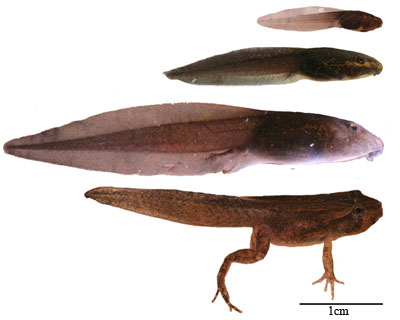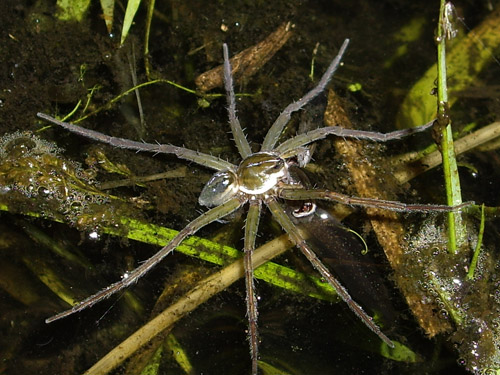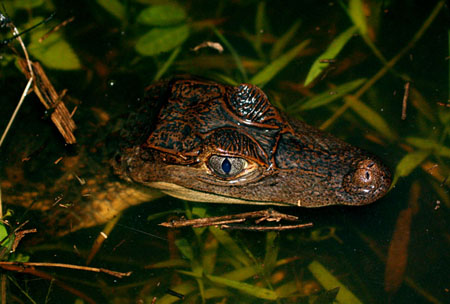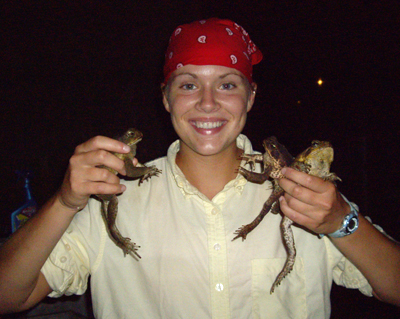Field Assistant Opportunity in Panama
Tadpole
Schooling and Parental Care in the frog,
Leptodactylus insularum

I am
looking for volunteer field assistants to study tadpole behavior and ecology
in the Neotropical frog Leptodactylus insularum at the Smithsonian
Tropical Research Institute in Gamboa,
Panama. My dissertation project focuses on the costs and benefits of tadpole
schooling and parental care in L. insularum. For this season I will
be combining field work with mesocosm experiments to quantify the effects
of density and schooling on growth and development. Please visit my research
page for a more detailed explanation of my project.
I will accept 3-4 volunteers to work for 2-6 month periods during mid-June
to mid-December (exact dates negotiable). I can not provide financial support
but students will have an incredible opportunity to learn a variety of research
techniques in a tropical, scientific community.
Background - Leptodactylus insularum breeds in temporary ponds and the tadpoles develop quickly, reaching metamorphosis in only 17 days. In order to grow and develop quickly, L. insularum tadpoles maintain high activity and feeding rates. This increased activity in tadpoles may increase predation risk, and L. insularum tadpoles may overcome this cost by forming dense aggregations. In order to quantify the costs of schooling, I combine field work and mesocosm experiments to test the hypothesis that high density will be costly to growth and development.
Responsibilities
- Assistants will work on all aspects of the project, focusing on tadpole
growth and development rates in the field and experimental enclosures.
FIELD WORK AT PONDS – collecting frog eggs, tadpoles, adults, and tadpole
predators (giant water bugs, semi-aquatic spiders); daily tracking of free-ranging
schools; performing behavioral observations on schools and attending female
frogs.
GENERAL LAB WORK – counting, photographing and developmentally staging
eggs and tadpoles; measuring tadpoles from photographs (using computer software);
MESOCOSM EXPERIMENTS – setting up kiddie pools (water, vegetation, tadpoles);
maintaining and checking mesocosms; collecting and feeding aquatic vegetation;
monitoring tadpole schooling behavior.


Kiddie pools for
mesocosm experiments (left). Developmental series of Leptodactylus insularum
tadpoles (right).
What to expect - Assistants must be comfortable handling frogs and tadpoles, as well as catching (with nets) their predators (giant water beetles, semi-aquatic spiders and freshwater eels). Field work is done in flooded fields and shallow swamps, and you must be comfortable standing in knee deep water for many hours and reaching your hands in to collect pond muck and vegetation (food for captive tadpoles). Although rewarding, working in a swamp is not for everyone. Please make sure that you are comfortable in the presence of large aquatic insects, semi-aquatic spiders, non-venomous snakes, caiman and MOSQUITOES!


Thaumasia sp. fishing spider with tadpole (left). Juvenile spectacled caiman (right).
Work hours - Unfortunately I can not set clear working hours since our work depends on the animals and the weather. The adult frogs are nocturnal, but the tadpoles are active 24 hours/day, so depending on the task you will be working days or nights. With 4-5 people working on the project we will be able to rotate to ensure adequate time off. You will have days off, but not necessarily the same days every week. If a large project arises (due to availability of eggs and tadpoles), we will work for 2-3 weeks with very little free time, and then take vacations after this. Panama has many lovely vacation destinations, so the only trouble will be deciding what to do!
Living in Gamboa - Housing will be offered through STRI, and volunteers will have the opportunity to live with volunteers and interns from other projects. You should expect to pay ~$400-450/month for housing. Gamboa in the rainy season is very warm and humid, and everything you own will eventually be covered in mold (even inside my camera!). This is part of the experience! Just make sure to get extended warranties on all new electronics (I learned this the hard way). In addition we can leave equipment in air-conditioned labs or dry closets.
Gamboa is a tiny Canal Zone neighborhood, nestled in the rainforest between the Panama Canal and Chagres River, and Soberania National Park. Wildlife is abundant and you will awake to (or curse when you are trying to sleep) a cacophony of parrots and other birds. On your free time you can explore local trails (or nearby Barro Colorado Island), go birdwatching on the famous Pipeline Road, catch frogs, search for monkeys, and just soak in the beauty of the rainforest. There’s also a fancy resort and pool, and weekly ultimate Frisbee!
.
Geoffrey's tamarin (left). Assistant Kathy Les (2007) with cane toads (right).
There is a healthy community of researchers in Gamboa and you will have the opportunity to interact with many different researchers. In the rainy season there are large numbers of researchers studying frogs and we meet weekly to discuss frog things. We closely interact with the large groups from both Prof. Karen Warkentin and Prof. Mike Ryan’s labs. Please check out the Living in Gamboa pdf from Prof. Warkentin’s intern website. She has had interns working with her in Gamboa since 2003 and has tons of wisdom.
What to bring – In addition to field clothes, each assistant will be required to bring knee-high rubber boots, headlamps, rechargeable batteries, and battery charger. I highly recommend Princeton Tec headlamps – a good light makes a big difference. Don’t be afraid to spend $50-$80, it’s worth it. I have lots of rechargeable batteries, but they die and an extra 4-8 AA per person would be ideal.
Qualifications – I am looking for highly motivated, independent, responsible assistants that are excited about biology and field work. Working in the field is tiring, and a good attitude makes a big difference! I will select assistants based on previous experience, skills relevant to the research, ability to work in field conditions, the ability to work alone and in groups and share housing.
———————————————————————————————————————————————————————
If you are interested, please email me the following materials by April 18th, 2008. I will continue to review applications for Summer and Fall 2008 until positions are filled. Please feel free to email me any questions before submitting your complete application.
- Application Form (download here).
- Personal Statement – Discuss why you want this position and how it would relate to your career goals. Maximum 2 pages.
- Statement of experience and skills. Relevant skills and experience include languages (English, Spanish), laboratory and field research, computers, photography, experience with animals and in natural environments, travel and cross-cultural experiences, interpersonal skills, teamwork, etc. This should include a CV or resume, and you may also add a narrative statement to highlight or describe in more detail your skills/experiences, or to tell us things relevant to your application that are not evident from a CV (e.g. You have no research experience with animals but you used to collect spiders as a child.)
- Two letters of recommendation. (Letters should address potential for a career in science, suitability for tropical rainforest field research, and interpersonal skills and character. Recommendations can be emailed to Kristiina Hurme.)———————————————————————————————————————————————————
To download this information as a pdf to print, click here.
 |
Kristiina Hurme, PhD Candidate |
Visits since March 20th, 2008
eCost
Coupon Codes
